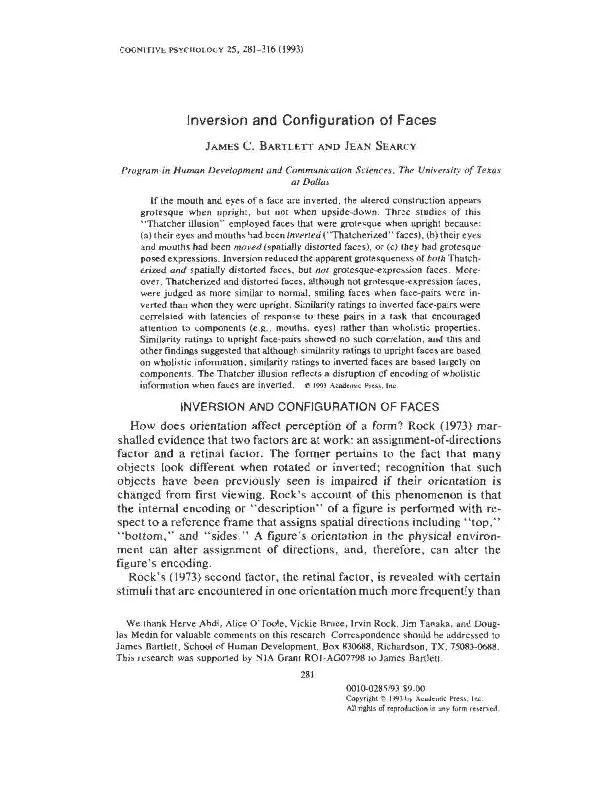

BARTLETTANDSEARCYinothersSomesuchmonoorientedstimuliareencodedmuchbetterwhenpresentedrightsideupieintheirusualorientationthanwhenpresentedupsidedownWordsincursivescriptandpicturesoffacesar ID: 286483
Download Pdf The PPT/PDF document "COGNITIVEPSYCHOLOGY25,281-316(1993)Inver..." is the property of its rightful owner. Permission is granted to download and print the materials on this web site for personal, non-commercial use only, and to display it on your personal computer provided you do not modify the materials and that you retain all copyright notices contained in the materials. By downloading content from our website, you accept the terms of this agreement.
COGNITIVEPSYCHOLOGY25,281-316(1993)InversionandConfigurationofFacesJAMESC.BARTLETTANDJEANSEARCYPrograminHumanDevelopmentandCommunicationSciences.TheUniversityofTexasatDallasIfthemouthandeyesofafaceareinverted,thealteredconstructionappearsgrotesquewhenupright,butnotwhenupside-down.Threestudiesofthis"Thatcherillusion"employedfacesthatweregrotesquewhenuprightbecause:(a)theireyesandmouthshadbeen("Thatcherized"faces),(b)theireyesandmouthshadbeen(spatiallydistortedfaces),(c)theyhadgrotesqueposedexpressions.Inversionreducedtheapparentgrotesquenessofspatiallydistortedfaces,butgrotesque-expressionfaces.More-over,Thatcherizedanddistortedfaces,althoughnotgrotesque-expressionfaces,werejudgedasmoresimilartonormal,smilingfaceswhenface-pairswerein-vertedthanwhentheywereupright.Similarityratingstoinvertedface-pairswerecorrelatedwithlatenciesofresponsetothesepairsinataskthatencouragedattentiontocomponents(e.g.,mouths,eyes)ratherthanwholisticproperties.Similarityratingstouprightface-pairsshowednosuchcorrelation,andthisandotherfindingssuggestedthatalthoughsimilarityratingstouprightfacesarebasedonwholisticinformation,similarityratingstoinvertedfacesarebasedlargelyoncomponents.TheThatcherjJlusionreflectsadisruptionofencodingofwholisticinformationwhenfacesareinverted.�«:1993AcademicPres..Inc.INVERSIONANDCONFIGURATIONOFFACESHowdoesorientationaffectperceptionofaform?Rock(1973)mar-shalledevidencethattwofactorsareatwork:anassignment-of-directionsfactorandaretinalfactor.Theformerpertainstothefactthatmanyobjectslookdifferentwhenrotatedorinverted;recognitionthatsuchobjectshavebeenpreviouslyseenisimpairediftheirorientationischangedfromfirstviewing.Rock'saccountofthisphenomenonisthattheinternalencodingor"description"ofafigureisperformedwithre-specttoareferenceframethatassignsspatialdirectionsincluding"top,""bottom,"and"sides.")Afigure'sorientationinthephysicalenviron-mentcanalterassignmentofdirections,and,therefore,canalterthefigure'sencoding.Rock's(1973)secondfactor,theretinalfactor,isrevealedwithcertainstimulithatareencounteredinoneorientationmuchmorefrequentlythanWethankHerveAbdi.AliceO'Toole.VickieBruce.IrvinRock,JjmTanaka,andDoug-lasMedinforvaluablecommentsonthisresearch.CorrespondenceshouldbeaddressedtoJamesBartlett,SchoolofHumanDevelopment,Box830688,Richardson,TX,75083-0688.ThisresearchwassupportedbyNIAGrantROI-AGO7798toJamesBartleU.0010-0285/93$9.00Copyright'tJ1993byAcademicPress.Inc.AUri~tsofreproductioninanyformreserved. BARTLETTANDSEARCYinothers.Somesuch"monooriented"stimuliareencodedmuchbetterwhenpresentedright-side-up(i.e.,intheirusualorientation)thanwhenpresentedupside-down.Wordsincursivescriptandpicturesoffacesaretwoexamples.Bothtypesofstimuliarepoorlyencodediftheyarein-verted-oriftheviewerisinverted-suchthattheassigneddirectionsoftopandbottomarereversedfromtheviewer'segocentricupanddown.ApuzzleconcerningtheretinalfactoristhediscoverybyYin(1%9)thattheeffectsofinversionaremuchstrongerwithfacesthanothermonoorientedstimuliincludingpicturesofairplanes,houses,stickfig-ures,periodcostumes,landscapes,anddogs(Yin,1969;Scapinello&Yarmey,1970;Diamond&Carey,1986).ThisprovocativeoutcomeledYintoproposea"specialfactor"thatisorientation-specificanduniquetofacestimuli.Thisideathatfacesare"special"(or"unique,"seeEllis&Young,1989)canbequestionedbasedonRock's(1973)observationthatcursive-scriptprocessingisdisruptedbyinversion.Itisalsoopposedtotherecentdemonstrationthateffectsofinversiononrecognitionmem-orycanbeasstrongwithdogsasfaces,solongasthesubjectshaveexpertknowledgeofthedogs(Diamond&Carey,1986).Inlightoftheprecedingresults,itappearsthatRock's(1973)retinalfactorarisesinthecourseofperceptuallearningwithsome(althoughperhapsnotall)monoorientedstimuli.Apparently,theskillsoneacquiresinprocessingsuchstimulicannotberecruited,orarepoorlyrecruited,whenthestimuliareinverted.Thisperceptualproblemmaybesolvedinsomecasesbyinternalcorrectionofaform'sorientation(e.g.,throughmentalrotation).However,withcomplexstimuliincludingfacessuchcorrectionisimpossibleorhighlyerror-prone(Rock,1973).Hence,theperceptualencodingisimpairedinsomeway.Acceptingthisconclusionasaworkinghypothesis,weareledtocer-tainquestionsofcentralimportancetotheoriesofperceptionandrecog-nitionmemory:Whataretheeffectsofperceptuallearningandwhyaretheyrestricted,atleastinsomecases,toasmallrangeoforientations?Whatsortofinformationispoorlyencodedwhensomemonoorientedstimuliarepresentedupside-down?Toanswersuchquestions,weneedtoknowmoreabouttheprocessingofstimulithatshoweffectsofinversion.Whatweneedtoknowmostisifprocessingsuchstimuliissimplyim-pairedbyinversion,orifitisalteredinaqualitativeway.Thepresentresearchwasaddressedtothisissue.Thequestionofwbetberinversioneffectsarequalitativeorquantitativehasbeenaddressedwithmorevigorinthedomainoffaceprocessingthaninotherresearchareas.Valentine(1988)reviewedtheface-processingresearch,andarguedthatalthoughinversionincreasestheerrorofen-coding(seeValentine,1991),thereisnopersuasiveevidencethatitcausesashiftfromonetypeofprocessingtoanother.StudiesbyTanaka--~-~--- andFarah(1991)andValentineandBruce(1988)lendsupporttothisDespiteValentine's(1988)arguments,severalfindingssuggestthatin-versionaffectsthetypeofinformationencodedfromaface.Sergent(1984)foundthatlatenciesfor"different"judgmentsinsimultaneouscomparisonsoffacesshowedinteractiveeffectsofdifferentfeature-changes,butonlywhenfaceswerepresentedupright.However,TakaneandSergent(1983)foundaninteractivepatternwithinvertedfacesalso.Bruce,Doyle,Dench,andBurton(1991)reportedthatinversionimpairedlearningofprototypeconfigurationsusingcomputer-drawnfacesandhousesasstimuli.However,therewasnoexaminationofinversionef-fectswithotherinformationbesidesconfigurations.StrongerevidenceforaqualitativeeffectofinversioncomesfromYoung,HeIlaweIl,andHay(1987),whoexaminedlatenciesfornamingpartsoffamousfaces(e.g.,tophalvesofthesefaces)whenpresentedwithcomplementarypartsofotherfamousfaces(e.g.,bottomhalves).Naminglatencieswerelongerwhenthepartswerealignedthanwhentheyweremisaligned,suggestingthatwholisticorconfiguralprocessingcaninterferewithnamingonepartofaface.Alignmentmadenodifferencewhenthestimuliwereinverted,sug-gestingaqualitativeeffectofinversionwherebywholisticorconfiguralinformationisselectivelydisrupted.However,itispossibletoargue,asValentine(1988)has,thatinversionisdisruptivetofacepro-cessing,adding"error"toconfiguralinformationaswellasfeatureorcomponentinformationcausingashiftinfaceprocessingfromonetypetoanother(seealsoValentine&Bruce,1988).TheMargaretThatcherIllusionThemostdramaticevidencethatinversioncancauseashiftinfaceprocessingisThompson's(1980)MargaretThatcherillusion,whichisshowninFig.1.Theillusioniscreatedbyinvertingthemouthandbotheyesofanotherwiseuprightface(notjustMrs.Thatcher's).Thealteredfaceappearshighlygrotesque,butthegrotesquenessisabsentwhenthewholeconstructionisinverted.TheThatcherillusionconfirmspriorevidencethatinversioninterfereswiththeprocessingoffacesandisavividillustrationofRock's(1973)retinalfactor.Moreimportant,theillusionappearstocompeltheconclu-sionthattheinformationencodedfromanuprightThatcherstimulusdif-fersinafundamentalwayfromthatencodedfromaninvertedThatcherstimulus.Hence,theillusionconstitutesacleardemonstrationthatinver-sioncanqualitativelyalterfaceprocessing.Butwhatisthenatureofthisqualitativeeffect?TheanswertothisquestionshouldhaveimportantimplicationsforaproperunderstandingofRock's(1973)retinalfactor, BARTLETTANDSEARCYFIG.I.AnexampleofanormalandThatcherizedface.andfortherelatedissueofhowperceptuallearningaffectsrecognitionofthevisualinformationweencounterinlife.TheoreticalAccountsoftheThatcherIllusionAccordingtoValentine(1988),theThatcherillusiondemonstrates.'...thatinversionofafacecanindeedhaveadramaticeffectupontheperceptionofexpression..."(p.484).Indeed,asimpleaccountoftheThatcherillusionholdsthat(a)thegrotesqueappearanceofaThatcher-izedfaceisduetoitsexpression,(b)inversionimpairstheencodingofexpression,and,therefore,(c)inversiondisruptstheperceptionofgro-tesquenessofaThatcherizedface.ThisexpressionhypothesisisinlinewithYin's(1970)suggestionthatthetypeoffacialprocessingmostaf-fectedbyinversionmightpertaintofacialexpression.ItalsoconvergeswithstatementsbyKohler(1940),aswellasmanypainters(Parks,Coss,&Coss,1985),thatinvertedfaceslackexpression,anditfitsDolezal's(1982)observationthatinvertingprismsdisruptedhisperceptionoffacialexpressions(albeitonlysubtleexpressions;hehadnotroublerecognizingovertsmiles).Finally,anexpressionhypothesisisconsistentwithexper-imentalandneuropsychologicalevidencethatfacial-expressionencodingisdissociablefromfacial-identityencoding(see,e.g.,Bruce,1988;Val- FACIALCONFIGURATIONentine,1988).Becauseofthisevidence,itistheoreticallyplausiblethatamoduleorsystemforexpressionencodingmightshowstrongerinversioneffectsthanmodulesorsystemsforrecognitionofidentity.However,aproblemfortheexpressionhypothesisisposedbyastudyofmentalrotationoffacesbyValentineandBruce(1988).Theseauthorsfoundthattheeffectsoforientationoffacesinanexpression-judgmenttaskwereweakerthanthoseinfamiliarity-judgmenttask,afindingopposedtotheexpressionhypothesis,AsecondaccountoftheThatcherillusionissomewhatmorecomplex.Parksandhiscolleagues(ParksetaI.,1985;Parks,1983)beganwiththeassumptiondrawnfromRock's(1973)theorythattheeffectofinvertingamonoorientedstimulusreflectstheinteractionoftwoframesofreference.Oneisanobject-centeredframeconveyedbythestructureofthestimulusitselfaswellasbypriorlearning.Theotherisanonobject-centeredframebasedontheexternalenvironment,or,alternatively,ontheviewer'segocentricsenseofupversusdownbasedonretinalcoordinates.Inanycase,whenamonoorientedstimulusispresentedupside-down,theas-signmentofdirectionsbasedontheobject-centeredframeisoppositetothatbasedonthenonobject-centeredframe,andthisweakenstheimpor-tanceoftheobject-centeredframe(Parks,1983).IPerhapsanyaccountofinversioneffectsmustconsiderinteractionsbetweenreferenceframes.ThekeyclaimmadebyParksetal.(1985)isthatthereferenceframesinvolvedinperceivingafaceaffecttheappear-anceoftheofthisface.Thus,theassignmentoftoptoonepartofamouth(i.e.,theupperversusthelowerlip)willaffectwhetherthemouthisseenasrepresentingasmileoragrotesque,biting,grimace.Asimilarargumentismadefortheeyeswhichmightappearopenandup-wardgazingorstrangelysquintedanddownwardgazingdependingupontheassignmentoftop.WhenThatcherizedfacesarepresentedupright,thelocationsoftopsandbottomsoffeaturesarereinforcedbybothref-erenceframes,and,therefore,thegrotesquenessoftheeyesandmoutharestable.However,whenThatcherizedfacesarepresentedinverted,thelocationsoftopsandbottomsoffeaturesvarywiththereferenceframe.Hence,theassignmentofdirectionstofeaturesisunstableandsotheimpressionofgrotesquenessdoesnotoccur.Inatestoftheframe-of-referencehypothesis,Parksetal.(1985)hadsubjectsratethepleasantnessofdrawingsofmouthsinuprightversusAlthoughParksetaI.(1985)arguedthatanenvironmentalreferenceframehelpedindeterminingthetopoffacialfeatures,Rock(1988)pointsoutthataretinalreferenceframeisprobablymoreimportant(e.g..onecanexperiencetheThatcherillusionbyleavingthepictureinuprightorientationandobservingthefacenormallyversuswithone'sheadin- BARTLETTANDSEARCYinvertedorientationwheneyeswereplacedabovethemandwheneyeswereplacedbelow.Inagreementwithpredictions,theyfoundthatanuprightmouthwasjudgedasmorepleasantwhenthelocationoftheeyesvis-a-visthemouthsupportedanassignmentoftoptothemouththatwouldindicateasmile(seealsoValentine&Bruce,1985).However,theauthorsalsofoundthatthejudgedpleasantnessofamouthwasaffectedbythedistancebetweentheeyesandmouth,whichwouldappeartobeaconfiguralproperty.Moreover,ratingsofpleasantnessoftheleledthoseofthethattheyaccompanied,despitethefactthattheeyeswereverticallysymmetric.Thesefindingssuggestthat,despitetaskinstructions,subjectsratedpleasantnessofeyesandmouthsatleastpartlyonthebasisofconfiguralinformation.AthirdaccountoftheThatcherillusionisbasedonafamilyofdistinc-tionsbetween(a)component(orpiecemealfeature)andconfigura!infor-mation(Bradshaw&Nettleton,1981;Carey&Diamond,1977;Ross-Kossak&Turkewitz,1984;Sergent,1984),(b)first-orderandsecond-orderinformation(Diamond&Carey,1986;Rhodes,1988),(c)relationsandattributes(Goldstone,Medin,&Gentner,1991),(d)globalandlocalinformation(Navon,1977),and(f)holisticandanalyticinformation(Kemler,1983).ThetermswewilluseinthepresentreportaretakenfromGarner(1978),whodistinguished"component"from"wholistic"stimu-luscharacteristics,discussingtwodifferenttypesofcomponentsandthreedifferenttypesofwholisticproperties.Thetwotypesofcompo-nents-featuresanddimensions-differinthattheformerareeitherpresentorabsent(e.g.,amoleonaface),whereasthelattercanexistattwoormoremutuallyexclusivelevels(e.g.,anoseofacertainshapeandsize).Thethreetypesofwholisticpropertiesaresimplewholes,template-basedpropertiesandconfigurations.Simplewholesarejustsumsofcomponents,andmayrepresentadegenerateconcept(Garner,1978).Template-basedpropertiespertaintothecoincidenceofstimuliwithmodaloraverageforms(e.g.,withprototypesorschemas).Con-figurationsareemergentpropertiesthatarisefromrelationsamongcom-ponents.Thebulkoftheface-processingliteraturehasblurredthedis-tinctionbetweenfeaturesandcomponents,aswellasthatbetweentemplate-basedpropertiesandconfiguralproperties(itisnotcleartousthatsimplewholeshavebeenconsidered).Hence,thedistinctionasitiscurrentlydrawncanbecapturedbytheterms"component"and"wholis-Toruleoutthisexplanation,ParksetaI.(1985)performedasecondexperimentinwhichtheeyeswereremovedfromthevisualfieldbeforesubjectsmadetheirjudgmentsofmouths.TheyreplicatedthefindingsofExperiment1,butwhenmouthswereininvertedorientation,whentheywereinuprightorientation.Thus,theuseofconfiguralinformationinExperiment)wasnotruledoutdefinitively.-~~- FACIALCONFIGURATIONtic."WesubsequentlyconsiderwhetherandhowthedistinctionmightbeTheThatcherillusioncanbeexplainedbytheviewthatwholisticandcomponentinformationisprocessedthroughdifferentperceptualstrate-giesormodes,andthatinversiondisruptsthewholisticmodemuchmorethanthecomponentialmode(seeCarey&Diamond,1977;Sergent,1984).DiamondandCarey(1986)putthisdual-modeviewasfollows:"Thomp-son's(1980)'Thatcherillusion'providesastrikingdemonstrationthatspatialrelationsamongfeaturescrucialintheperceptionofuprightfacesarenotapparentwhenfacesareupsidedown"(p.107).Rock(1988)arguessimilarlythat''Inviewinganinvertedfaceitisdifficulttocopewiththerelationshipoftheparts,"andthat"...inThompson's[in-verted]picture,therelationshipoftheinvertedfeaturestotherestofthefaceisnotadequatelyperceivedandthusthegrotesquenessisnotper-ceivedeither"(p.817).Justwhythewholisticprocessingmodeisaffectedbyinversionhasnotbeenmadeclear.However,GoldsteinandChance(1980)haveproposedtheexistenceofafaceschema,builtupinthecourseofperceptuallearn-ing,thatenhancestheencodingofuprightfacesbutnotthatofinvertedfaces.Theseauthorssaylittleaboutthenatureoftheschema,butRhodes,Brennan,andCarey(1987)havedevelopedtheideathatfacesarestoredintermsoftheirdifferencesfroma"normface,"whichcap-turesmajorcontoursofamodaloraveragefaceinatemplate-likeformat(i.e.,atwo-dimensionalarray,seealsoBenson&PeITett,1991).Simi-larly,Yuille(1991)hasproposed"deformabletemplates"thathavead-justableparametersrepresentingallowabledeformationsofaschematicface(globaltemplates,seeFischler&Elschlager,1973),andindividualfacialfeatures(featuretemplates).Afaceisencodedthrough(a)compar-isonwiththetemplates,(b)adjustmentoftheparametersofthesetem-plates,and(c)determinationofthegoodness-of-fitbetweentheadjustedtemplatesandtheface.NeitherYuille(1991)norRhodesetat(1987)discussedthecausesofretinalinversioneffects.However,bothnormfacesanddeformabletem-platesarevisuospatialrepresentationswithwelldefinedtopsandbot-toms.Toencodeinvertedfacesusingsuchrepresentationswouldrequireaprocessofmentalrotationwhichpreservesspatialrelationsinahighlypreciseway.Mentalrotationwithhighresolutionmightbeimpossiblewithinvertedfaces(Rock,1973).Ifso,template-basedprocessingmightbeprecludedwithsuchfaces.WefollowGarner(1978)inourspellingof"wholistic,"andnotethatRhodes'(1988)definitionof"second-orderinformation"isclosertothatofwholisticinformationthanisDiamondandCarey's(1986)earlierdefinition. BARTLETTANDSEARCYInsummary,theThatcherillusioncanbeexplainedontheassumptionthatuprightThatcherfaceshavepoorfitstotemplatesfornormfaces.Thesepoorfitsarethesourceoftheimpressionofgrotesqueness.Sinceinversionisdisruptivetotemplate-basedprocessing,poorfitstotem-platescannotbedetectedwithinvertedThatcherfaces.Hence,invertedThatcherfacesdonotappeargrotesque.EXPERIMENT1TowardthegeneralgoalofimprovingourknowledgeofRock's(1973)retinalfactor,wetestedthedual-modehypothesisagainsttheframe-of-referenceandexpressionhypothesesastheoreticalaccountsoftheThatcherillusion.Wemanipulatedphotographsof14smilingfacestoproducethreetypesofgrotesquelytransformedfaces:(a)"Thatcher-ized"imagesinwhichthemouthsandeyeswereinverted,(b)"type-I"distortedimagesinwhichthemouthswereloweredandtheeyesweremovedupandclosertogether,and(c)"type-2"distortedimagesinwhichthemouthsweremovedupandtheeyesweremoveddownandfartherapart.Wealsoselectedneutral-andgrotesque-expressionversionsofeachfacestimulus,examplesofwhichareshowninFig.2.Ourquestionwashowinvertingfacestimuliwouldaffecttheirjudgedgrotesqueness.Ifinversiondisruptsexpressionencoding(theexpressionhypothesis),itshouldreducethegrotesquenessofgrotesque-expressionfacesaswellasthatofThatcherizedfaces.Itmightreducegrotesque-nessofthetype-Iandtype-2distortedfaceswhosegrotesquenessisduetothelocationsoftheirfeaturesandarguablynottofacialexpression.Adifferentpredictionfollowsfromthereference-framehypothesis.Accord-ingtothisview,theapparentgrotesquenessofThatcherizedfacesreflectsanunusualassignmentofdirectionstotheireyesandmouths,andinver-sionsimplyweakensthisassignmentofdirections.Itfollowsfromthisreasoningthat:(a)inversionshouldreducethegrotesquenessofThatch-erizedfaces,but(b)itshouldreducegrotesquenessoftheothertypesoffaceswhicharegrotesqueforotherreasonsthanassignmentofdirec-Stillanotherpredictionfollowsifinversiondisruptsprocessingofwholisticinformation(thedual-modehypothesis).Inthiscase,inversionshouldreducegrotesquenessoftype-landtype-2distortedfacesaswellasgrotesquenessofThatcherizedfaces,althoughitmightgrotesquenessofgrotesque-expressionfaces.ThereasoninghereisthatbothdistortedfacesandThatcherizedfaceshavebeenalteredwithrespecttowholisticproperties(i.e.,configuralinformationand/ordevia-tionsfromtemplates).Thisisnotobviouslytrueofthegrotesque-expressionfaces.----~ FACIALCONFIGURATIONFIG.2.ExamplesofaThatcherizedfacetogetherwithagrotesque~expressionandneu-tral-expressionversionofthisface(toprow),andanormal,type-Idistortedandtype-2distortedversion(bottomrow).Subjectsandprocedure.Thesubjectswere20undergraduates(70%female;meanage,27years)attheUniversityofTexasatDallaswhoparticipatedasonemeansoffulfillingapsychologycourserequirement.GroupsofIto4subjectswereseatedapproximately5feetfromthe2t-inchmonitoronwhichallstimuliweredisplayed.Theyweretoldthattheywouldseeasetoffacessomeofwhichhadbeendistorted,andhalfofwhichwereupside BARTLETTANDSEARCYdown.Thetaskwastorateeachfacefor"grotesqueness"usingaseven-pointscale(7,mostgrotesque).Thestimuliwerepresentedinarandomizedsequencefor5seach,witha2-sinterstimulusinterval.The12subjectsintheexpressiongroupviewedastimulus-setcomposedoftheThatcherized,smiling-expression,neutral-expression,andgrotesque-expressionversionsofeachface.The8subjectsinthedistortiongroupviewedanoverlappingstimulussetcom-posedoftheThatcherized,smiling-expression.type-I-distortedandtype-2-distortedver-sionsofeachface(seeFig.1).Sinceeachstimulus-setincludedfourdifferentversionsofeachof14faces,bothpresentationsequencescontained56uprightface-stimuliand56invertedface-stimuli,presentedinarandomizedsequenceof112stimuli.ThematerialswerederivedfromEkman's(1975)picturesof6maleand8femalefacesofmodelsposingvariousexpressions.Foreachoftbe14models,wechoseapictureshowinganormalsmilingexpression,apictureshowinganeutralexpression,andapictureshowingwhattheexperimentersjudgedtobethemostgrotesqueexpressionofallthephotographsofthatmodel.ThepicturesweredigitizedusingaTamronFotovixvideoprocessoranda286-typecomputerequippedwitha16-bitTargaboardandTruevisionimage-processingsoftware(TIPS).TheTIPSsoftwarewasusedtoplaceeachfaceinanovalframewhichreducedbutdidnotentirelyeliminatehairandbackgroundinformation(seeFig.2).Thepictureswerealsoalteredinsizetoproduceanimagethatwasapproximately6x5incheswhendisplayedona21-inchmonitor.Inaddition,wetransformedthepleasantlysmilingpictureofeachfacetoproduce(a)aThatcherizedversionbyinvertingthemouthandbotheyes,(b)aspatiallydistortedversionbymovingthemouthdownwardandtheeyesupwardandclosertogether(typeI),and(c)asecondspatiallydistortedversionbymovingthemouthupwardsandtheeyesdownandfurtherapart(type2).Thesetransformationsweremadebyinvertingormovingrectangularface-regionsthatcloselyframedtherelevantfeaturesandthenobscuringtheedgesoftheseface-regionsthroughtheblendingoperationinTIPS.Wedidnotpreciselycontrolthesizeoftheface-regionsthatwereinvertedormoved,orthedistancestraversedwhentheregionsweremoved-ourgoalinmakingeachtransformationwastoproduceafacethatlookedgrotesquewhenupright.TheimagesweretransferredtoopticaldiscusingaPanasonic2026Fopticaldiscplayer/recorderupgradedtoSVHSquality.Theopticaldiscunit,controlledbythecomputer,wasusedforpresentationofthefacesona21-inchSVHSvideomonitor.Lookingfirstattheexpressioncondition,TableIshowsthatinversionslightlyincreasedgrotesquenessratingsforsmilingandneutral-expressionfaces,whiledramaticallyreducinggrotesquenessratingsforThatcherizedfaces.Turningtothedistortioncondition,theeffectsforsmilingandThatcherizedfaceswerereplicatednicely,andtheratingsofthespatiallydistortedfacesbehavedaspredictedbythedual-modehy-pothesis:bothtypesofdistortedfaceswerejudgedassignificantlylessgrotesquewhenpresentedupsidedown.Theratingsweresubjectedtotwoanalysesofvariance(ANOVAs),onefortheexpressionconditionandtheotherforthedistortioncondition.Attheconventionalalphalevelof.05,bothANOVAsshowedreliableeffectsoforientation,11)=18.1,=.25intheexpressioncondition,and=49.8,=.43,inthedistortioncondition.Theyalsoshowed FACIALCONFIGURATIONTABLE1Mean"Grotesqueness"Ratings(andStandardDeviations)forUprightandInvertedFacesintheExpressionandDistortionConditionsofExperiment1Note.liSwere12and8intheexpressionanddistortionconditions,respectively.Gro-tesquenessratingsrangedfrom((least)to7(most)...Theinversioneffectgave.05byreliableitem-typeeffectsandreliableitem-typexorientationinterac-=65.0and97.5,MSe=.508and.161,respectively,intheexpressioncondition,and=59.5and55.7,MSe=.462and.116,respectively,inthedistortioncondition.ThedatafromthedistortionconditionsuggestedthatinversionreducedgrotesquenessratingsforThatcherizedfacesthanforspatiallydis-tortedfaces.Indeed,theitem-typexorientationinteractionwasstatis-ticallyreliableinacomparisonofThatcherized,type-I,andtype-2dis-tortedfaces,=35.9,=.106,anditremainedreliableincomparisonsofThatcherizedwithtype-ldistortedfaces,7)=40.8,=.164,andwithtype-2distortedfaces,=51.6,MSe=.087.Despiteahintthatinversionhadstrongereffectsontype-2distortedfacesthantype-Idistortedfaces,anitem-typexorientationinteractionwasnotsupportedinanANDVAcomparingthesetwoitem-types.Toassessthegeneralityofourfindingsacrossitems,wecomputedthemeangrotesquenessratingforeachuprightandinvertedfacepresentedtoeachgroupandplottedthegrotesquenessofinvertedfacesagainstthatofuprightfaces.AsshowninFig.3.all28Thatcherizedfaces,and26ofthe28(93%)type-l-andtype-2-distortedfaces,werejudgedlessgrotesquewheninvertedthanwhenupright.Incontrast,only14ofthe56(25%)unalteredfaces(smiling-,neutral-,andgrotesque-expressionitems)werejudgedlessgrotesquewhenviewedupsidedown.NotethatthepointsforThatcherizeditemsweregenerallyfurtherbelowthepositivediagonalthanwerethepointsfordistorteditems.ThissupportstheconclusionthatItem-typeinexpressioncondition2.50(.85)6.73(.27)4.72(.56)3.12(.93)3.89(.82)3.54(.77)4.78(.69)-0.62*2.84*Item-typeindistortionconditionDistortion1Distortion22.12(.92)6.18(.64)5.56(.52)5.40(.45)2.46(.77)3.42(.93)4.63(.44)4.14(.69)-0.34*0.93*1.26* [I)44)"-1Zt4~go3BARTLETTANDSEARCY...GROTESQUEEXPRESSION'"NEUTRALEXPRESSIONTT6\1.;;,\1'V.T~'V.666T6...'V'V.SMILINGEXPRESSION6.:'"",'"'"."'.",.f.'\7'V..GROTESQUENESSUPRIGHTFIG.3.TheeffectofinversionongrotesquenessratingsforindividualfacesinExperi-mentI.EachsmilingandThatcherizedfaceisrepresentedbytwopoints,onefortheexpressionconditionandoneforthedistortioncondition.Superimpositionsoccurredat=2.0(twosmilingfaces);=4.09.4.50(twogrotesquefaces);X=6.88,=4.38(twoThatcherizedfaces);and=6.13,=3.63,and=5.75and=5.00(adistortion-IandaThatcherizedfaceinbothcases).inversionreducedgrotesquenessofThatcherizedfacesmorethanthatofspatiallydistortedfaces,thoughitsignificantlyreducedthegrotesquenessofboth.TheeffectsofinversiononThatcherizedandspatiallydistortedfacescannotbeattributedtotheirhighlevelofgrotesquenesswhenpresentedright-sideup.Figure3showsthatseveralgrotesque-expressionfaces(in-verted,filledtriangles)werejudgedalmostasgrotesqueassomeThatch-erizedfaces(blacksquares),andmoregrotesquethansomespatiallydistortedfaces(upright-andinverted-emptytriangles),whenpresentedright-sideup.Yet,thesegrotesque-expressionfacesdifferedfromtheThatcherizedandspatiallydistortedfacesintheirhighgrotesquenessratingswhenpresentedupsidedown.OuraiminthisstudywastotestthreeaccountsoftheThatcherillusion.Themajorclaimoftheexpressionhypothesiswasthatgrotesqueexpres-sionsarelessgrotesquewheninverted.Thereference-framehypothesisheldthatthegrotesquenessofThatcherizedfacesreflectsthegrotesque-nessoftheirindividualcomponents(i.e.,theirinvertedmouthsandeyes)..'VDISTORTION26DISTORTION1IITHATCt-ER FACIALCONFIGURATIONwhen"top"isassignedtowhatisnormallythe"bottom"ofthesecom-ponents(ParksetaI.,1985).Suchanunusualassignmentofdirectionsissupportedbytworeference-frameswhenThatcherfacesareupright.butthesereferenceframesconflict-andtheassignmentofdirectionsisthere-foreunstable-whenThatcherfacesareinverted.Accordingtothedual-modeaccount,inversiondisruptsprocessingofwholisticinformation(j.e.,configuralinformationordeviationsfromtemplates),whichisthesourceofthegrotesquenessofThatcherizedfaces.Theexpressionhypothesiswasfirmlyrejected,asthegrotesque-expressionfaceswerejudgedaslessgrotesquewhenupside-downthanright-sideup.Indeed,the(unreliable)trendwasintheoppositedirection(Table1,top).Theframe-of-referencehypothesisfailedtopre-dicttheeffectofinversionwithspatiallydistortedfaces.Thedual-modehypothesiswasstronglysupportedinthattwotypesofspatiallydistortedfacesweresimilartoThatcherizedfacesinbeingjudgedaslessgrotesquewheninvertedthanwhenupright.Sincebothtypesofspatiallydistortedfaceswerealteredwithrespecttowholisticinformation,thefindingsup-portstheclaimthatwholisticencodingisimpairedbyinversion.Thefindingthatinversionofgrotesque-expressionfacesdidnotreducetheirjudgedgrotesquenesssupportsthedual-modehypothesis,butitisnonethelesssurprisinginviewofpainters'observationsofthenonexpres-sivecharacterofupside-downfaces(Parksetal.,1985).However,itispossibletoarguethatinversionintenereswiththeperceptionofexpres-sionswithoutmakingthoseexpressionsseemanylessgrotesque.ThispossibilityisaddressedinExperiment2.AfindingpredictedbynohypothesisweconsideredwasthatalthoughinversionaffectedgrotesquenessratingsofbothThatcherfacesanddis-tortedfaces,theeffectwithThatcherfaceswasstronger.Onepossibleaccountisthatinversiondisruptswholisticencodingandsubjects'reference-framesforencodingeyesandmouths.BothfactorswouldbeoperativewithThatcherizedfaces,butonlythefactorofwholis-ticencodingwouldbeoperativewithspatiallydistortedfaces.Analter-nativeandmoreparsimoniousviewisthatinversioneffectsreflecttem-plate-basedencoding,andnotalltypesofwholisticinformationareequallydependentontemplate-basedencoding.Specifically,orientationoffeatures(alteredinThatcherizedfaces)mightbemoreperceptuallysubtlethanspatial-locationoffeatures(alteredindistortedfaces),andencodingoftheformermightbemoredependentontemplatesfornormStillathirdviewdrawsonRock's(1973)claimthatifamonoorientedstimulusispresentedupside-down,somesortofperceptualcorrectiontakesplace.Ifthestimulusiscomplex(e.g.,ifitisaface),thiscorrectionoccursseparatelyforindividualcomponents.Thatcherfacesconstitutea BARTLETTANDSEARCYspecialcasebecausewhensuchfacesareviewedupside-down,theireyesandmouthsareright-sideup,andplausiblysubjecttoacorrectionoperation.Sincethesecomponentsarepleasantwhenviewedright-sideup,theinvertedThatcherfaceappearsquitepleasant.Incontrast,whendistortedfacesareviewedupside-down,alloftheircomponents(includ-ingeyesandmouth)wouldbesubjecttocorrection.Theymightretainsomegrotesquenesstotheextentthatcorrectionpreservesspatialrela-RegardlessofthereasonswhyinversioneffectsweregreaterforThatcherizedfacesthandistortedfaces,themainconclusionofthisstudyisclear:Inversionimpairswholisticencoding.Thisisconsistentwiththedual-modehypothesiswhichdistinguishestwoface-processingmodes,oneforwholisticinformationandtheotherforcomponentinformation.Experimentlb.AnarguableweaknessofExperimentIisthatnogro-tesque-expressionfacewasjudgedasgrotesqueasanyThatcberizedfacewithuprightpresentation(seeFig.3).Thus,acriticmightarguethatgrotesque-expressionfacesthataregrotesque-justasgrotesqueasuprightThatcherfaces-mightbejudgedaslessgrotesquewhenpre-sentedupsidedown.Totestthispossibility,wevideotapedeachofsevenindividualsposingfourdifferentexpressions,oneneutralexpression,onesmilingexpression,andtwodifferentgrotesqueexpressions(theywerecoachedtomaketheirfacesasuglyastheycould).WecapturedimagesfromthevideotapesoncomputerharddiscusingTIPSsoftware,andconstructedThatcherizedversionsofthesmilingandneutral-expressionpictures.Thisproducedasetofsixpicturesforeachofthe.sevenmodels(smiling,neutral,Thatcherized-smiling,Thatcherized-neutral,grotesque-expression1,andgrotesque-expression2).Weplacedeachofthe42imagesinanovalframethatmaskedmostofthehairandallclothingasinExperiment1.Theseimagesweretransferredtoopticaldiscinuprightasinvertedorientation.Theresultingsetof84imageswasdis-playedtosubjectsviaa21-inchmonitorinarandomizedsequenceattherateof7sperimage(stimulusduration,5sandinterstimulusinterval,2s).TheninesubjectswerefromthesamesourceusedinExperiment1.Theirtaskwassimplytorateeachimageforgrotesquenessusingaseven-pointscale(7,mostgrotesque).TheresultsreplicatedthoseofExperiment1,but,toourinitialdisap-pointment,theupright-grotesque-expressionfacesagainreceivedlowergrotesquenessratingsthantheupright-Thatcherizedfaces.Fortunately,wewereabletoidentify4(of14)Thatcherstimuliand4(of14)grotesque-expressionstimuliwhosemeanratedgrotesquenessintheuprightcondi-tionwasapproximatelyequal3.94and4.03,respectively,..WethankIrvinRockforsuggestingthisthirdaccount. FACIALCONFIGURATION.73and1.38,respectively).Despiteequivalentgrotesquenessintheup-rightcondition,thegrotesque-expressionstimuliwerestillgrotesquewheninverted=4.75,=1.25),whereastheThatcherstimuliweregreatlyreducedingrotesqueness=2.75,=.71).TwoANDYAsshowedthatthestimulus-typexorientationinteractionwassignificantwithsubjectstreatedastherandomfactor,=20.5,=.402,andalsowithitemstreatedastherandomfactor,=32.5,.113(p.002inbothcases).Noothereffectsreachedconventionalsignificancelevels.EXPERIMENT2OneofouraimsforExperiment2wastoclarifythefindingthattheratedgrotesquenessofgrotesque-expressionfaceswasreducedbyinversioninExperiment1.Ourpreferredinterpretationofthiscounter-intuitivefindingisthattheprocessingofexpressioninthepresentstudywasimpervioustoinversion.However,analternativeviewisthatinver-sioncanimpairtheprocessingofexpressionwithoutmakinganexpres-sionseemanylessgrotesque(e.g.,bymakingtheexpressionseemlesssincereorrealistic).Tomorerigorouslyexaminewhetherinversioncanaffecttheprocessingofexpression,wehadsubjectsgiveratingsoftheperceptualsimilaritybetweenfaceswithgrotesqueandneutralexpres-sionsandthesesamefaceswithsmilingexpressions.Ifinversionimpairstheperceptionofexpression,itshouldincreasesubjects'ratingsofper-ceptualsimilarity.AnotheraimofExperiment2wastotesttheimplicationofthedual-modehypothesisthattheeffectsofinversionshoulddependnotonlyonthenatureofthestimuli,butalsoonthetask:Ifataskevokesawholisticmodeofprocessingwhenfacesareupright,inversioneffectsshouldbestrongand(i.e.,theyshouldbestrongerwithThatcheranddistortedfacesthanwithgrotesque-expressionfaces).Thereasonissim-plythatthewholisticmodeofprocessingusablewithuprightfacescannotbeemployed,orisemployedwithgreatdifficulty,withupside-downfaces.However,ifataskevokesacomponentialmodeofprocessingwhenfacesareupright,inversioneffectsshouldbesmalland(Le.,anyeffectsshouldbenogreaterforThatcheranddistortedfacesthanforgrotesque-expressionfaces).Thereasoninghereisthatcompo-nentialprocessingispresumedtobepossibleregardlessoforientation.AccordingtoSergent(1984),tasksofsimultaneouspaired-comparisonsoffacesoftenevokeacomponentialstrategy,especiallywhensubjectsareundertimepressure.Ifso,inversionshouldhaveminimaleffectsinsuchtasks,evenifThatcherizedfacesareused.Totestthislineofrea-soning,thepresentexperimentexaminednotonlyasimilarityratingtask~------~-- BARTLETTANDSEARCYthatallowedfortheuseofconfiguralprocessingbutalsoasame-different-facejudgmenttaskthatwasdesignedtoencourageonlycomponentialBothtasksincludedthreetypesofface-pairsinwhichoneitemwasalwaysanunaltered,smilingfaceandtheotherwas:(a)aThatcherizedversionofthisface,(b)atype-1ortype~2distortionofthisface,and(c)thisfacewithagrotesqueorneutralexpression.Ifsimilarityratingsarebasedatleastpartlyonconfiguralinformation,inversionshouldincreasethejudgedsimilarityofsmiling-Thatcherpairsaswellassmiling-distortionpairs.However,ifsame-differentfacejudgmentsarebasedoncomponents,inversionshouldreducethelatencyofcorrectsame-facejudgmentsinresponsetothesesamepairs.Subjectsandmaterials.The35subjectsweresimilartothoseusedinExperiment).Thefacestimuliwerealsothesameasbefore,exceptthatheretheywerepresentedasside~by-sidepairsalwayscomprising:(a)anormaL,smiling,facenextto(b)achanged-expressionface,aThatcherizedface,oraspatiallydistortedface.Onlysame-facepairs(i.e.,twodifferentversionsofthesameperson'sface)werepresentedinthesimilarity-ratingtask,butdifferent-facepairs(i.e.,pairsinwhichfacesoftwopersonswereshown)wereincludedinthesame-different-faceclassificationtask.Thedifferent-facepairswereproducedbypairingeachofthe)4modelswithoneoftheothermodels,matchingbygender,anattemptingtomakeageandgeneralappearanceassimilaraspossible.ExamplesareshowninFigs.4,5,and6.UsingthesamecomputergraphicssoftwareandopticaldiscapparatusasinExperiment),allface-pairswereconstructedsuchthateachofthetwofaceswerein6x5-inchovalswithoneappearingontheleftsideofthe(21inch)screenandtheotherappearingontherightsideofthescreen.Eachpairoffaceswaspresentedfourtimes:(1)inuprightorien-tationwiththenormal,smilingversionontheleftsideofthescreen;(2)inuprightorien-tationwiththisversionontheright;(3)ininvertedorientationwiththenormal,smilingversionontheleftsideofthescreen;and(4)ininvertedorientationwiththisversionontheApproximatelyhalf(18)ofthesubjectsservedintheexpressioncondition,inwhichthepresentationsequenceincludedequalnumbersofrandomlyintermixedsmiling/neutral-expressionpairs,smiling/grotesque-expressionpairs,andsmilingffhatcherpairs.Theremaining(17)subjectsservedinthedistortioncondition,inwhichthesequencein-cludedequalnumbersofsmiling/type-)distortedpairs,smilingltype-2distortedpairs,andsmilingffhatcherpairs.Allofthesubjectsperformedasimilarityratingtaskfol1owedbyasame-differentclas-sificationtask.Thesimilarityratingsweremadeto168same-facepairscreatedthroughpresentingeachofthe14normal,smilingfaceswitheachofthreetypesofcomparisonfaceintwospatialarrangements(normalfaceontheleftversusright)andtwoorientations(uprightversusinverted).Thesame-differentclassificationsweremadetothesesame168same-facepairsrandomlyintermixedwithanadditional168different-facepairs.Priortothesimilarity-ratingtask,subjectsweretoldthattheywouldseeasequenceofsame-facepairs,andthattheyshouldrespondtoeachpairwithajudgmentofhowsimilartheleft-handstimuluswastotheright-handstimulus,usingaseven-pointscaleonwhichIreferredtopairsthatwerethemostsimilarorhardesttotellapartand7referTed----- FAC(ALCONFIGURATIONFIG.4.AnexampleofaThatcherpairshowinganormal,smilingversionofonefaceandaThatcherizedversionofadifferentface.topairsthatweretheleastsimilaroreasiesttotellapart.Eachstimulus-pairwaspresentedfor5s,followedbya2-sinterstimulus-intervalforsubjectstorespondbycirclingnumbersontheiranswersheets.Priortothesame-differentclassificationtask,subjectsweretoldthattheywouldseeanothersequenceofface-pairs,buttbat,thistime,halfofthepairswouldshowfacesofdifferentpersons.Theirtaskwastojudge,asquicklyaspossiblewithoutsacrificingaccu-racy,whethereachpaircomprisedpicturesofthesamepersonoroftwodifferentpeople.Notethatthistaskinvolvedmaking"same"judgmentstoallsame-facepairs,includingThatcheranddistortionpairswhichweredifferentwithrespecttowholisticinformation.Hence,attendingtoandusingwholisticinformationwasconsistentwithtaskdemands,atleastnotwithThatcheranddistortionpairs.Subjectsrespondedintheclassificationtaskbypressingoneoftwotelegraph�keys-~nelabeled"same"andtheotherlabeled"ditTerent"-usingtheindexfingersoftheirleftandrighthands.Theassignmentofkeysto"same"versus"different"wasreversedforhalfthesubjects.The336-itemsequencewasprecededbyJOpracticetrials,withfeedback,usingpairsoffacesdrawnfromadifferentsetofstimuli.Similarityratings.Consideringfirsttheexpressioncondition,thetopofTable2showsthattherewasareliableincreaseinjudgedsimilaritywhenThatcherpairswereinvertedbutnotwhenneutral-orgrotesque-expressionpairswereinverted.Turningtothedistortioncondition,thebottomofTable2showsthattheeffectofinversionwithThatcherpairs BARTLETTANDSEARCYFIG.5.Anexampleofatype-ldistortedpairshowinganormal,smilingversionandatype-Idistortedversionofthesameface.wasonceagainrobust.Theeffectofinversionwithdistortionpairswassomewhatlessrobust,butitwasnonethelessreliableandinthesamedirection.ANOVAsoftheexpressionanddistortionconditionssup-portedmaineffectsforpair-type,=6.04,=1.47and=11.8,=.399,respectively,maineffectsfororientation,=.769and=122.4,=.448,respectively,andpair-typexorientationinteractions,=68.0,=.150and=27.8,=.150,respectively.ThepatternofdataconvergewiththegrotesquenessratingsofExperimentI(Table1):JustasstimulusinversionreducedjudgedgrotesquenessofbothThatcherizedfacesandspatiallydistortedfaces,butnotgrotesque-orneutral-expressionfaces,italsoincreasedjudgedsimilarityofbothThatcherizedandspatiallydis-tortedfaces,butnotgrotesque-orneutral-expressionfaces,totheirun-altered,smilingmates.Subjectsfoundthistasktobedif-ficult,andtheyfailedtorespondwithintheallotted3son12%ofthetrialsintheexpressioncondition,and6%ofthetrialsinthedistortioncondi-tion.Theconditionalprobabilitiesofcorrectclassifications,giventhatajudgmentwasmade,areshowninTable3.Twofindingsstandout.First,correctsamejudgmentsweresubstantiallymoreprobablethancorrectdifferentjudgmentswiththeThatcheranddistortionpairs,butnotwith--- FACrALCONFIGURAnONFIG.6.Anexampleofagrotesque-expressionpairshowinganormal.smilingversionandagrotesque-expressionversionofthesameface.changed-expressionpairs,suggestingabiastojudgetheformerpairsas"same."Second,inversioneffectsweregenerallysmall,althoughtherewassomeevidencethatinversionreducedaccuracyofresponsestoneu-tral-andgrotesque-expressionpairs,andpossiblytodistortion-2pairs(ondifferent-facetrials).Accuracyversusbiaseffects.Todistinguishaccuracyfrombiaseffects,wecomputedscores(Grier,1971)fromhitrates(i.e.,thevaluesinrows1,2,7,and8ofTable3),andfalse-alarmrates,(Le.,1.0minusthevaluesinrows4,5,10,andItofTable3).generallyvaryfrom.5(chancediscrimination)to1.0(perfectdiscrimination),whereasvaryfrom-1.0(strongestbiasforaresponse)to0(nobias)to+1.0(strongestbiasagainstaresponse).scoresintheexpressionconditionsuggestedthatinversionimpairedaccuracyofperformancewithneutral-expressionpairs(means=.75and.67fortheuprightandinvertedconditions,respectively),andgrotesque-expressionpairs(Ms=.72and.68,respectively),butnotwithThatcherpairs.66and.65,respectively).Thescoresinthedistortionconditionshowedlessevidenceforinversioneffectsuprightversusinvertedpresentationwere.76versus.74fortype-ldis-tortionpairs,.77versus.73fortype-2distortionpairs,and.74versus.76forThatcherpairs).AnANOVAofA'siniheexpressioncondition BARTLETTANDSEARCYBeyondthis,however.thereislittlewecansay.Whetherthisinformationconsistsofdeviationsfromglobaltemplates(Yuille,1991),orasdevia-tionsfrom"first-order"spatialrelations(Diamond&Carey,1986),orwhethertheseideascanevenbedistinguished,hasyettobedetermined.Wealsolackknowledgeastowhetherorhowthewholistic/componentdistinction,asoperationalizedhere,relatestodistinctionsbetweenrela-tionsandattributes(GoldstoneetaI.,1991),globalversuslocalinforma-tion(Navon,1977),andholisticversusanalyticinformation(Kemler,1983).Moreresearchoneffectsofdifferentfacialtransformationsunderdifferenttaskconditionsisobviouslyrequired.Benson,P.J..&Perrett,D.l.(l99\).Perceptionandrecognitionofphotographicqualityfacialcaricatures:Implicationsfortherecognitionofnaturalimages.EuropeanJournalofCof?nitil'ePsychology,3,105-135.Bradshaw.J.L.&Nettleton.N.C.(1981).ThenatUreofhemisphericspecializationinTheBehavioralandBrainSciences,4,51-94.Bruce,V.(1988).Recognizingfaces.Hillsdale,NJ:Erlbaum.Bruce,Y.,Doyle.T.Dench.N..&Burton,M.(1991).Rememberingfacialconfigurations.38,109-144.Bruce,V.,&Young.A.(1986).Understandingfacerecognition.BritishJournalofPsychol-77,305-327.Carey,S.(1991.November).De~'elopmentaldifferencesinholisticproces.~in~offaces?Paperpresentedatthe32annualmeetingofthePsychonomicSociety,SanFrancisco.Carey.S.,&Diamond,R.(1977),FrompiecemealtoconfiguraIrepresentationoffaces.Corballis.M.C.0988).Recognitionofdisorientedshapes.Psycholo[?icalRe\,iew,95,115-Diamond.R..&Carey,S.(1986).Whyfacesareandarenotspecial:Aneffectofexpertise.JournalofExperimentalPsychology:General,US,107-117.Dolezal,H.(1982),aworldtransformed:Perceptualandperformatoryadaptationtovisualdistortion.NewYork:AcademicPress.Ekman,P.(1975).Picturesoffacialaffect.PaloAlto,CA:ConsultingPsychologistsPress.Ellis.H.D..&Young.A.W.(1989).Arefacesspecial?InA.W.Young&H.D.EllisHandbookofresearchonfaceprocessing.(pp.1-26).NewYork:North-Fischler.M.&Elschlager.R.A.(1973).TherepresentationandmatchingofpictorialIEEETransactionsonComputers,22,1.Garner,W.R.(1978).Aspectsofastimulus:Features,dimensions.andconfigurations.InE.Rosch&B.B.Lloyd(&Is.),CoRnitionandcategorization(pp.99-133).Hillsdale,NJ:Erlbaum.Gnier,J.B.(1971).Nonparametricindexesforsensitivityandbias:Computingformulas.PsychologicalBulletin,75,424-429.Goldstein.A.G..&Chance.J.(1980).Memoryforfacesandschematheory.JournalofGoldstone.R.L..Medin,D.L.,&Gentner.D.(199)).Relationalsimilarityandthenon-independenceoffeaturesinsimilarityjudgments.CognitivePsychology,23.222-262.